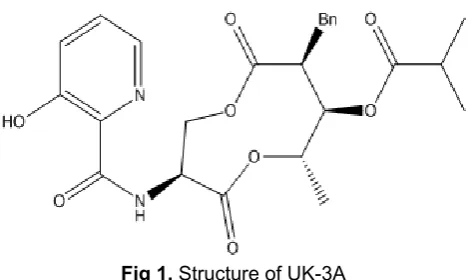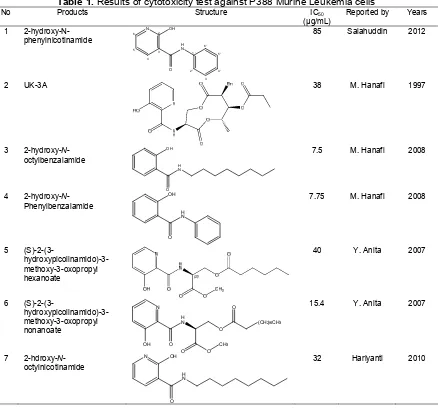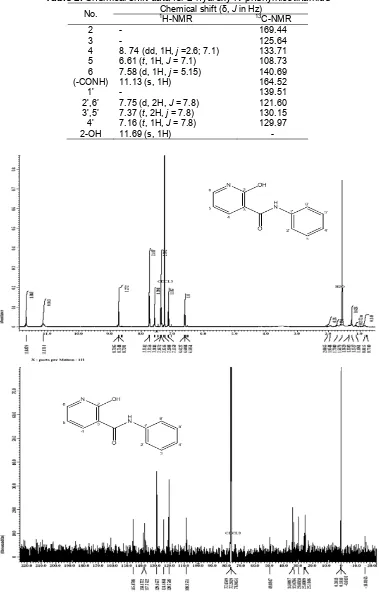Salahuddin et al.
* Corresponding author. Tel/Fax : +62-85772199113 Email address : [email protected]
SYNTHESIS AND ANTICANCER ACTIVITY TEST OF
2-HYDROXY-N-PHENYLNICOTINAMIDE
Salahuddin1,2,*, Muhammad Hanafi2,3, and Hariyanti1
1
Faculty of Pharmacy, University of Uhamka, Perumnas Klender 13460, Jakarta, Indonesia
2
Research Centre for Chemistry – LIPI, Kawasan Puspiptek, Tangerang 15314, Indonesia
3
Faculty of Pharmacy, University of Pancasila, Lenteng Agung, Jakarta 12640, Indonesia
Received March 5, 2013; Accepted June 30, 2013
ABSTRACT
The novel compound of 2-hydroxy-N-phenylnicotinamide was synthesized from modification of the UK-3A compound, which was known biologically active to inhibit bacterial and cancer cells growth. Synthesis of this compound was carried out in one-step reaction. Analog UK-3A compound namely 2-hydroxy-N-phenylnicotinamide was synthesized from 2-hydroxynicotinic acid as the starting material using amidation reaction with aniline in presence of DCC/DMAP in pyridine. Analog UK-3A was analyzed and identified using TLC, IR, LC-MS and FT-NMR spectrophotometer. The yield after purification was 42.97%. The IC50 value 85 μg/mL was obtained from cytotoxicity test against P388 Murine Leukemia cells. It indicated that the synthesis products were sufficiently potential for leukemia P388 treatment.
Keywords: 2-hydroxy-N-phenylnicotinamide; UK-3A; amidation; P388 Murine Leukemia cells
ABSTRAK
Senyawa baru 2-hiroksinikotinil fenilamida telah disintesis dari modifikasi senyawa UK-3A, yang telah diketahui aktif secara biologi menghambat pertumbuhan bakteri dan sel kanker. Sintesis senyawa ini dilakukan dengan satu tahap reaksi. Senyawa analog UK-3A yaitu 2-hidroksinikotinil fenilamida disintesis dari asam 2-hidroksinikotinat sebagai bahan awal menggunakan reaksi amidasi dengan anilin terhadap DCC/DMAP dalam piridin. Analog UK-3A dianalisis dan diidentifikasi menggunakan KLT, FT-IR, LC-MS, FT-NMR spektrofotometer. Diperoleh rendemen setelah dipurifikasi sebesar 42,97%. Nilai IC50 diperoleh sebesar 85 μg/mL diperoleh dari uji sitotoksisitas terhadap sel leukemia murin P388. Ini mengindikasikan bahwa produk sintesis cukup berpotensi terhadap leukemia P388.
Kata Kunci: 2-hidroksinikotinil fenilamida; UK-3A; amidasi; sel leukemia murin P388
INTRODUCTION
Streptomyces sp. 517-02, from which a novel cytotoxic benzoxazole UK-1, antifungal nine membered dilactones UK-2A, B, C and D, antifungal antibiotic nine-membered UK-3A were previously isolated [1]. With a little yield obtained from isolation, UK-3A compound has anticancer potent to develop [2]. At present various research groups worldwide are involved in search of more safe anti-inflammatory and anticancer agents [3-6]. Cancer is the second leading cause of death [7] worldwide after cardiovascular diseases, according to WHO. Indeed, lung, breast, stomach, liver and colorectal cancers are the largest causes of death worldwide each year, and therefore the discovery and the development of suitable agents to treat various types of cancer are highly desirable [8].
Salahuddin et al.
Fig 1. Structure of UK-3A
From the above process, UK-3A (Fig. 1) has three different pharmacopore groups, namely hydroxyl group on pyridine, amide group, and dilactone group. Retro-synthesis of UK-3A is used to obtain three commercial reagents (market ready) L-serine, 2-hydroxylnicotinic acid, and alcohol.
Anticancer active compound with simple molecule structure, easy step to synthesize, will give us more chances to treat and faces cancer diseases. With the same steps like synthesis of 2-hydroxy-N-phenylnicotinamide, there’s a chance to synthesize another simple compound with the same or more biologically active than original compound [10]. Analog synthesis is advantageous due to its short duration and high probability of yielding a more active compound by modifying the structure, and it’s also give information about the structure activity-relationship [11].
This research was focused on the nine membered dilactone ring itself, which was replaced by suitable mimetic structure, as shown in Fig. 1, and also we want to report the result of cytotoxic assay by changing nine membered dilactone ring with aniline.
EXPERIMENTAL SECTION
Materials
The compound was prepared from 2-hydroxynicotinic acid (Sigma) as the main material. 1,3-dicyclohexylcarbodiimide (DCC) and 4,4-dimethylaminopyridine (DMAP) were used as the activator and catalyst. Dry pyridine (E. Merck) was used as solvent.
Instrumentation
Column chromatography was carried out using Merck silica gel 60 GF254 and for TLC analysis precoated silica gel plates (Merck Kiesel-gel 60 GF254, 0.25mm) were used. Visualization of TLC plates was performed using ninhydrin spray reagents and UV lamp 254 nm. Identification and purification of the compound were
established by spectrophotometer LC-MS HP 5972
series, FT-IR Spectrophotometer Shimadzu 2010 A. 1H and 13C-NMR spectra were recorded at 500 MHz on JEOL (JNM-ECA).
Procedure
Amidation
The appropriate 2-hydroxynicotinic acid (2 mmol) was dissolved in pyridine (5 mL) and aniline (2.2 mmol) was added, followed by addition of DCC (2.2 mmol) and DMAP (0.2 mmol). The reaction mixture was heated to 55 °C and allowed to stir at this temperature for 24 h. After stirring for 24 h at 55 °C, the mixture was acidified with HCl 2% and extracted with ethyl acetate. The combined organic layers were washed with 1% NaOH solution and brine, and dried over MgSO4. The filtrate was concentrated and purified by silica gel column chromatography (hexane 40%-ethyl acetate 60%) to give the condensation product [12].
Cytotoxicity assay
P388 cells seeded into 96-well plates at an initial cell density of approximately 3x104 cells cm-3. After 24 h of incubation of cell attachment and growth, varying concentrations of samples were added. The compound added was first dissolved in DMSO at the required concentration. Subsequent six desirable concentrations of samples were prepared using PBS (phosphoric buffer solution, pH 7.30-7.65). Control wells received only DMSO. The assay was terminated after 48 h incubation period by adding MTT reagent [3-(4,5-dimethyl-thiazol-2-yl)-2,5-diphenyl tetrazolium bromide; also named as thiazol blue] and the incubation was continued for another 4h, in which the MTT-stop solution containing SDS (sodium dodecyl sulphate) was added and another 24 h of incubation was conducted. Optical density was read by using a micproplate reader at 550 nm. IC50 values were taken from the plotted graph of percentage live cells compared to control (%), receiving only PBS and DMSO, versus the tested contraction of compounds (μM). The IC50 value was the concentration required for 50% growth inhibition. Each assay and analysis was run in triplicate and averaged [13-15].
RESULT AND DISCUSSION
Salahuddin et al.
Fig 2. Synthesis of UK-3A Analog (2-hydroxy-N-phenylnicotinamide)
Table 1. Results of cytotoxicity test against P388 Murine Leukemia cells
No Products Structure IC50
(μg/mL)
Reported by Years
1 2-hydroxy-N-phenylnicotinamide
OH
2
N
6
5 4
3
H N
1'
2' 3
4' 5' 6'
O
85 Salahuddin 2012
2 UK-3A 38 M. Hanafi 1997
3 2-hydroxy-N -octylbenzalamide
OH
H N
O
7.5 M. Hanafi 2008
4 2-hydroxy-N -Phenylbenzalamide
OH
H N
O
7.75 M. Hanafi 2008
5
(S)-2-(3- hydroxypicolinamido)-3-methoxy-3-oxopropyl hexanoate
40 Y. Anita 2007
6
(S)-2-(3- hydroxypicolinamido)-3-methoxy-3-oxopropyl nonanoate
N
OH
H N
O CH3 O
O
(CH2)6CH3 O
O
15.4 Y. Anita 2007
7 2-hdroxy-N -octylnicotinamide
N OH
H N
O
32 Hariyanti 2010
obtained product in 42.97%. The product was established by LC-MS shown molecular ion at: m/z 215.23 m/z [M+H]+, which was the molecular weight of amidation product (M=214.23). The presence of amide (CONH) was identified by the FT-IR absorption at 3309.85 cm-1.
Salahuddin et al.
Table 2. Chemical shift data for 2-hydroxy-N-phenylnicotinamide
Chemical shift (δ, J in Hz)
No. 1
H-NMR 13C-NMR
2 - 169.44
3 - 125.64
4 8. 74 (dd, 1H, j =2.6; 7.1) 133.71 5 6.61 (t, 1H, J = 7.1) 108.73 6 7.58 (d, 1H, j = 5.15) 140.69 (-CONH) 11.13 (s, 1H) 164.52
1' - 139.51
2',6’ 7.75 (d, 2H, J = 7.8) 121.60 3',5’ 7.37 (t, 2H, j = 7.8) 130.15 4' 7.16 (t, 1H, J = 7.8) 129.97
2-OH 11.69 (s, 1H) -
Salahuddin et al.
determined by the signal proton at δH 7.16-7.75, as shown in Table 2. The signals of phenyl aromatic chain was also determined by δC 121.60-139.51, and the signals 1H and 13C for CONH were seen at δH and δC at 8.74; 164.5, respectively.
UK-3A compound had been isolated from the mycelium of Streptomyces sp. 517-02 [1]. The compound was then acknowledged to have a high activity against mouse leukemia cells, P388 (IC50 = 38
μg/mL) [2]. The cytotoxicity of 2-hydroxy-N-phenylnicotinamide was evaluated against murine leukemia P388 cells. This compound has anticancer against P388 leukemia cells with IC50 85 μg/mL lower than UK-3A (IC50 = 38 μg/mL), as shown in Table 1. The IC50 values indicated that the synthesis products were sufficiently potential for leukemia P388 treatment.
Analog is compound having a structure similar to that of another one, but different from it in respect of a certain component. It can differ in one or more atoms, functional groups, or substructures, which are replaced with other atoms, groups, or substructures. A structural analog can be imagined to be formed, at least theoretically, from the other compound. Analog UK-3A (2-hydroxy-N-phenylnicotinamide) has pharmacopore groups, namely amide group and hydroxyl group on pyridine. UK-3A has three different pharmacopore groups, namely hydroxyl group on pyridine, amide group, and dilactone group. Structure modification of UK-3A analog here was done by changing dilactone close chain with variation of hydrocarbon chains. That is the reason why 2-hydroxy-N-phenylnicotinamide should be called as a UK-3A analog.
CONCLUSION
Synthesis of UK-3A analog as an anticancer active compound has been done by one simple step of reaction (amidation). In vitro test to leukemia P388 cells demonstrated that the inhibition to growth of cancer cells with the IC50 for 2-hydroxy-N-phenylnicotinamide was 85
μg/mL, respectively. The IC50 values indicated that the synthesis products were sufficiently potential for leukemia P388 treatment.
ACKNOWLEDGEMENT
This research was supported by Indonesian Institute of Sciences (LIPI) and the Directorate General of Higher Education (DGHE or DIKTI), which were gratefully appreciated.
REFERENCES
1. Ueki, M., Kusumoto, A., Hanafi, M., Shibata, K., Tanaka, T., and Taniguchi, M., 1997, J. Antibiot., 50, 551–555.
2. Hanafi, M., 1995, Studies of Novel Antibiotic
Metabolites from Streptomyces Sp. 517-02,
Department of Chemistry, Faculty of Science, Osaka City University
3. Moutevelis-Minakakis, P., Papavassilopoulou, E., Michas, G., Georgikopoulou, K., Ragoussi, M-E., Neophytou, N., Zoumpoulakis, P., Mavromoustakos, T., and Hadjipavlou-Litina, D., 2011, Bioorg. Med. Chem., 19, 9, 2888–2902 4. Marrero-Ponce, Y., Siverio-Mota, D.,
Gálvez-Llompart, M., Recio, M.C., Giner, R.M., García-Domènech, R., Torrens, F., Arán, V.J., Cordero-Maldonado, M.L., Esguera, C.V., de Witte, P.A., and Crawford, A.D., 2011, Eur. J. Med. Chem., 46, 12, 5736–5753.
5. Tripodi, F., Pagliarin, R., Fumagalli, G., Bigi, A., Fusi, P., Orsini, F., Frattini, M., and Coccetti, P., 2012, J. Med. Chem., 55, 5, 2112–2124.
8. Rajitha, C., Dubey, P.K., Sunku, V., Piedrafita, F.J., Veeramaneni, V.R., and Pal, M., 2011, Eur. J. Med. Chem., 46, 10, 4887–4896.
9. Zhang, Y., Lv, Z., Zhong, H., Geng, D., Zhang, M., Zhang, T., Li, Y., Li, K., 2012, Eur. J. Med. Chem., 53, 356–363.
10. Darmawan, A., Hanafi, M., and Anita, Y., 2008,
Proceeding of the International Seminar on Chemistry, Jatinangor, 735–738.
11. Arsianti, A., Hanafi, M., Saepudin, E., Morimoto, T., and Kakiuchi, K., 2010, Bioorg. Med. Chem. Lett., 20, 14, 4018–4020.
12. Anita, Y., Hanafi, M., Putra, A.M.J., Arifin, S., Usuki, Y., and Lio, H., 2007, Indo. J. Chem., 7, 2, 214–217
13. Usuki, Y., Adachi, N., Fujita, K-I., Ichimura, A., Lio, H., and Taniguchi, M., 2006, Bioorg. Med. Chem. Lett., 16, 12, 3319–3322.
14. Sahidin, and Hakim, EH. 2006, Cytotoxic Properties of Oligostillbenoids from the Tree Barks of Hopea Dryobalamides. 60c, 723.
15. Shimano, M., Kamei, N., Shibata, T., Inoguchi, K., Itoh, N., Ikari, T., and Senda, H. 1998.
Tetrahedron, 54, 42, 12745–12774


